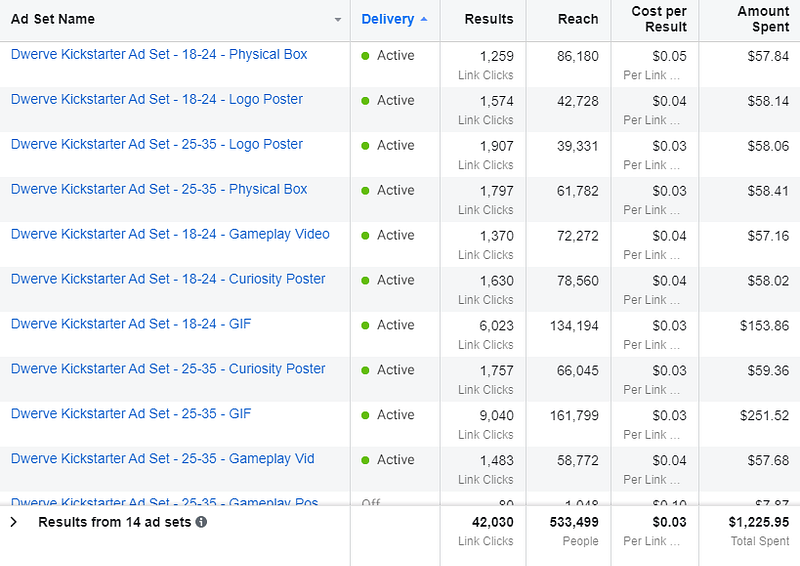NOTE: This article has been updated by the author with a new technical article on the same topic for 2023, here."
When Dwerve originally approached me to consult with their Kickstarter’s Facebook Ads, they were getting between $0.20 and $0.45 Cost-Per-Click and had no idea how to analyze their conversion rate.
While there wasn’t much time to prepare, I was able to quickly reduce the cost-per-click down to an average of 3 pennies, or $0.03. I accomplished this without click-bait copywrite, and instead used Facebook’s algorithm to our advantage via best-practices and highly-relevant, compelling copywrite and creatives.

Results of Ad Campaign
Results of Ad Campaign
There are a number of parts to this ad system. I won’t go into a tutorial-level of detail on how to accomplish certain basics of FB Ads, but you should be able to find those tutorials elsewhere on Google. If you are struggling getting set up with anything in particular, please leave a comment or send me an email at MattOlick3D@Gmail.com ; I am happy to help you move your project forward.
To get a closer look at what our Kickstarter page looks like, for study purposes, you can visit Dwerve’s kickstarter here:
https://www.kickstarter.com/projects/halfhumangames/dwerve-tower-defense-dungeon-crawler-rpg
Moving forward, let’s do a brief rundown of the funnel:
Facebook Page
The Ad
Redirect URL
Kickstarter Page
Pledge Checkout
Automated Kickstarter Messaging
Survey URL or Value Offer
The main challenge with Kickstarter is that you cannot place a pixel on the Kickstarter page itself. So you need to work around this by creating your own Redirect Pages at both the beginning and end of the customer’s journey.
Let’s go over each part of the system in-depth:
— -
#1 Facebook Page
— -
You can either use your product page, or create a secondary page exclusively for Kickstarter advertisements. I do recommend the latter, for the following reason:
We want people to know this is a Kickstarter, but we want to be subtle. The association with Kickstarter itself can be distasteful to consumers, because they know they are funding development of a product that may not materialize, rather than buying a product outright and receiving it immediately. For this reasoning, it may be more effective to clue viewers in that this is a Kickstarter via the advertiser’s page name (such as “Backer Bear”, or “Indie Crowdfunded Projects”), rather than putting Kickstarter’s brand directly in the ad’s creative or main copywrite.
— -
#2.1 Ad Campaign
— -

Graph of Campaign Structure
Graph of Campaign Structure
I recommend using the “Conversion Objective” when setting up your campaign in Facebook’s Ad Manager. This allows us to track the number of conversions per ad inside the Ad Manager, and Facebook can optimize to serve our ads to find those most likely to convert based upon interests, page likes, and demographic.
To have access to this campaign objective, however, we need to create and utilize both the “PageView” and “Purchase” standard events on our Facebook Pixel. Go to the Event Manager in the FB Ad Manager, and create those events.
Another thing you must do, is set the Attribution Window for your pixel to 28 days. Navigate to the Ad Account Settings, click “Edit” under Attribution, and set the Click Window to 28 days.
Once you have that done and set the campaign objective to “Conversions”, we want to utilize some best practices for a broad campaign on Facebook:
Segment our campaigns by country, continent, or otherwise region
Use “Campaign Budget Optimization”, which will automatically invest the budget in the best-performing Ad Sets
Start out with a Campaign Budget of $5 x total number of active ads, plus some extra wiggle room
Use Lowest-Cost Bidding Strategy
Let’s talk about the Ad Sets next, and best practices here to let Facebook optimize for us:
Do not specify the Gender. Allow Facebook to weigh genders per Ad Set on it’s own. It will do a better job internally than if you manually try to specify.
Segment Ad Sets by age group: 18–24, 24–34, 34–45, etc.
Do not manually specify ad placements or devices. I’ve always had worse results using manual placements with a broad audience. Facebook optimizes this very well internally, and will spend wisely.
Set the Minimum Ad Spend per Ad Set to $5, to ensure actionable data.
Before we move into ads, we still have to set up our Audience Targeting.
Assuming that you have a mailing-list (if not, you should definitely have one by now, and you want at least 3000 emails), upload your mailing list and turn that into a Custom Audience, and then create a 1% Look-A-Like Audience from that custom audience. Use your 1% Look-A-Like Audience as the Ad Set audience.
Now add the following interests to your targeting:
Kickstarter
IndieGoGo
Crowdfunding
GoFundMe
IMPORTANT NOTE:
Use Post-Linked IDs when duplicating your ads between age-group and country segments (There is a drop-down for “Create Ad” when creating an Ad, but you should instead select “Existing Ad”). Post-Linked IDs will retain the comments, likes, and shares between the ads which use the same creative/copywrite.
Be sure to answer all comments that viewers write on your ads!
— -
#2.2 Ad Creative



































